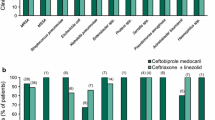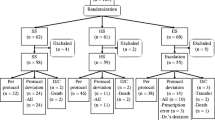Abstract
Once-daily trovafloxacin 200 mg was compared with high-dose amoxicillin, 1 g three times daily, given for 7 to 10 days. At end of treatment (day 10), the response was clinically successful (cure + improvement) in 93% of 152 clinically evaluable trovafloxacin patients and in 89% of 160 amoxicillin patients. At study end (day 35), respective rates were 91% and 81% (95% confidence interval: 1.6, 17.6; P=0.01). In evaluable patients with positive baseline radiographs, 93% of trovafloxacin and 88% of amoxicillin patients demonstrated radiological resolution at end of treatment.Streptococcus pneumoniae andHaemophilus influenzae eradication rates were comparable at end of treatment in both treatment groups, but at study endStreptococcus pneumoniae eradication rates were higher in trovafloxacin patients (100% vs 81%). At study end, all four trovafloxacin patients with baseline penicillinresistantStreptococcus pneumoniae were clinically cured with pathogen eradication, whereas two of five amoxicillin patients with baseline penicillin-resistantStreptococcus pneumoniae were clinical failures with pathogen persistence. For patients in whom no pathogen was identified, trovafloxacin was significantly more effective at end of treatment (P=0.096) and study end (P=0.013). Treatment-related adverse events were comparable; the most common were headache, vomiting and dizziness in trovafloxacin patients, and diarrhoea, headache and abdominal pain in amoxicillin patients.
Similar content being viewed by others
References
Bates JH, Campbell GD, Barron AL, McCracken GA, Morgan PN, Moses EB, Davies CM: Microbial etiology of acute pneumonia in hospitalized patients. Chest (1992) 101:1005–1012
LaForce MF: Antibacterial therapy for lower respiratory tract infections in adults: a review. Clinical Infectious Diseases (1992) 14, Supplement 1:233–237
Rodnick JE, Gude JK: Diagnosis and antibiotic treatment of community-acquired pneumonia. Western Journal of Medicine (1991) 154:405–409
British Thoracic Society Research Committee and the Public Health Laboratory Research Service: The aetiology, management and outcome of severe community-acquired pneumonia in the intensive care unit. Respiratory Medicine (1992) 86:7–13
Fang G, Fine M, Orloff J, Arisumi D, Yu VL, Kapoor W, Grayston JT, Wang SP, Kohler R, Muder RR, Yee YC, Rihs JD, Vickers RM: New and emerging etiologies for community-acquired pneumonia with implications for therapy. Medicine (1990)69:307–316
Bariffi F, Sanduzzi A, Ponticiella A: Epidemiology of lower respiratory tract infections. Journal of Chemotherapy (1995) 7:263–276
Pachon J, Prados MD, Capote F, Cuello JA, Garnacho J, Verano A: Severe community-acquired pneumonia: etiology, prognosis, and treatment. American Review of Respiratory Disease (1990) 142:369–373
Briggs-Gooding B, Jones RN: In vitro antimicrobial activity of CP-99,219, a novel azabicyclo-naphthyridone. Antimicrobial Agents and Chemotherapy (1993) 37:349–353
Eliopoulos GM, Klimm K, Eliopoulos CT, Ferraro MJ, Moellering RC: In vitro activity of CP-99,219, a new fluoroquinolone, against clinical isolates of gram-positive bacteria. Antimicrobial Agents and Chemotherapy (1993) 37:366–370
Gootz TD, Brighty KE, Anderson MR, Schmieder BJ, Haskell SL, Sutcliffe JA, Castaldi MJ, McGuirk PR: In vitro activity of CP-99,219, a novel 7-(3-azabicyclo[3.1.0]hexyl)-naphthyridone antimicrobial. Diagnostic Microbiology and Infectious Disease (1994) 19:235–243
Appelbaum PC: Quinolone activity against anaerobes: microbiological aspects. Drugs (1995) 49, Supplement 2:76–80
Roblin PM, Kutlin A, Hammerschlag MR: In vitro activity of trovafloxacin againstChlamydia pneumoniae. Antimicrobial Agents and Chemotherapy (1997) 41:2033–2034
Kenny GE, Cartwright FD: Susceptibilities ofMycoplasma pneumoniae, Mycoplasma hominis, andUreaplasma urealyticum to a new quinolone. trovafloxacin (CP-99.219). Antimicrobial Agents and Chemotherapy (1996) 40:1048–1049
Edelstein PH, Edelstein MAC, Ren J, Polzer R, Gladue RP: Activity of trovafloxacin (CP-99,219) againstLegionella isolates: in vitro activity, intracellular accumulation and killing in macrophages and pharmacokinetics and treatment of guinea pigs withL. pneumophila pneumonia. Antimicrobial Agents and Chemotherapy (1996) 40:314–319
Kim YS, Liu Q, Chow LL, Tauber MG: Trovafloxacin in treatment of rabbits with experimental meningitis caused by high-level penicillin-resistantStreptococcus pneumoniae. Antimicrobial Agents and Chemotherapy (1997) 39:1186–1189
Paris M, Hickey SM, Trujillo M, Shelton S, McCracken GH: Evaluation of CP-99-219, a new fluoroquinolone, for treatment of experimental penicillin-and cephalosporin-resistant pneumococcal meningitis. Antimicrobial Agents and Chemotherapy (1995) 39:1243–1246
Klugman KP, Wasas A: In-vitro activity of the fluoroquinolone CP-99,219 against penicillin-resistantStreptococcus pneumoniae. Journal of Antimicrobial Chemotherapy (1995) 36:873–874
Fine MJ, Smith DN, Singer DE: Hospitalization decision in patients with community-acquired pneumonia: a prospective cohort study. American Journal of Medicine (1990) 89:713–721
American Thoracic Society: Guidelines for the initial management of adults with community-acquired pneumonia: diagnosis, assessment of severity, and initial microbial therapy. American Reviews of Respiratory Disease (1993) 148:1414–1426
Trémolières D, DeKock A, Pluck N: Empirical treatment of nonsevere community-acquired pneumonia: still a difficult issue. European Respiratory Journal (1995) 8:1996–1998
Child J, Andrews J, Boswell F, Brenwald N, Wise R: The invitro activity of CP-99,219, a new napthyridone antimicrobial agent: a comparison with fluoroquinolone agents. Journal of Antimicrobial Chemotherapy (1995) 35:869–876
Pontani D, Washton H, Bouchillon S, Johnson J: Susceptibility of European respiratory tract isolates to trovafloxacin, ciprofloxacin, clarithromycin, azithromycin and ampicillin. European Journal of Clinical Microbiology & Infectious Diseases (1998) 17:413–419
Eisen SA, Miller DK, Woodward RS, Spitznagel E, Przybeck TR: The effect of prescribed daily dose frequency on patient medication compliance. Archives of Internal Medicine (1990) 150:1881–1884
Gootz TD, Zaniewski R, Haskell S, Schmieder B, Tankovic J, Girard D, Courvalin P, Polzer RJ: Activity of the new fluoroquinolone trovafloxacin (CP-99,219) against DNA gyrase and topoisomerase IV mutants ofStreptococcus pneumoniae selected in vitro. Antimicrobial Agents and Chemotherapy (1996)40:2691–2697
Barry AL, Brown SD, Fuchs PC: In-vitro selection of quinolone-resistant staphylococcal mutants by a single exposure to ciprofloxacin or trovafloxacin (CP-99,219). Journal of Antimicrobial Chemotherapy (1996) 38:324–327
Köhler T, Michéa-Hamzehpoor M, Plésiat P, Kahr AL, Pechère J-C: Differential selection of multidrug efflux Systems of quinolones inPseudomonas aeruginosa. Antimicrobial Agents and Chemotherapy (1997) 41:2540–2543
Vincent J, Teng R, Dogolo LC, Willavize SA, Friedman HL: Effect of trovafloxacin, a new fluoroquinolone antibiotic, on the steady-state pharmacokinetics of theophylline in healthy volunteers. Journal of Antimicrobial Chemotherapy (1997) 35, Supplement B: 75–80
Author information
Authors and Affiliations
Rights and permissions
About this article
Cite this article
Trémolières, F., de Kock, F., Pluck, N. et al. Trovafloxacin versus high-dose amoxicillin (1 g three times daily) in the treatment of community-acquired bacterial pneumonia. Eur. J. Clin. Microbiol. Infect. Dis. 17, 447–453 (1998). https://doi.org/10.1007/BF01691581
Issue Date:
DOI: https://doi.org/10.1007/BF01691581




